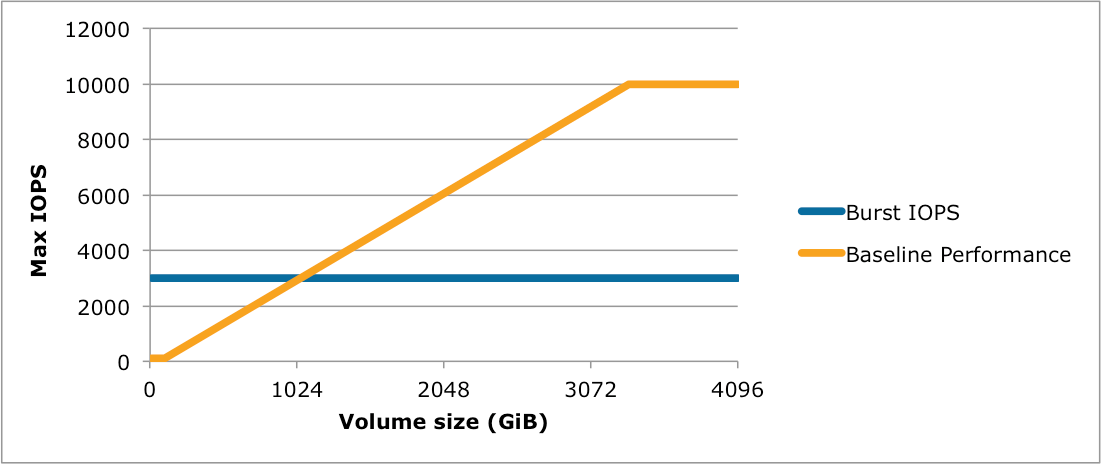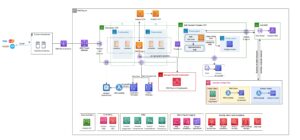Burst credit in AWS is a system that allows instances to temporarily burst beyond their baseline performance level. This burstable performance capability can be used to handle temporary spikes in workload without incurring additional charges.
Burst credit in AWS is an important feature for optimizing resource utilization and cost efficiency in cloud computing. It allows instances to operate at a higher performance level for a limited duration, helping businesses manage variable workloads effectively. Understanding burst credit is essential for maximizing the benefits of AWS services and ensuring optimal performance for cloud-based applications.

Credit: docs.aws.amazon.com
Introduction To Burst Credit In Aws
Burst Credit in AWS refers to the system where EC2 instances earn credits over time to burst performance when needed. This feature allows instances to operate above their baseline performance for short durations, ideal for workloads with fluctuating demands.
The Concept
In the world of cloud computing, burst credit is an essential concept that plays a crucial role in optimizing the performance of your AWS (Amazon Web Services) instances. Burst credit acts as a currency that allows your instances to burst beyond their baseline performance level for a limited period of time.
When an instance is running below its baseline performance level, it accumulates burst credits. These credits can then be utilized to burst above the baseline, providing higher performance when required. Burst credit is a valuable resource that enables your instances to handle sudden spikes in workload without compromising overall performance.
Importance In Cloud Computing
Burst credit is particularly important in cloud computing as it allows instances to efficiently handle bursts of workload without the need for constant scaling or over-provisioning of resources. This flexibility helps optimize costs and ensures smooth performance for your applications.
By intelligently managing burst credits, AWS instances can effectively handle short-term spikes in resource demand. This is especially beneficial for applications with variable workloads, where burst credits enable instances to scale up during peak times and scale down during periods of low activity.
Efficient utilization of burst credits helps maintain a balance between performance and cost effectiveness in AWS environments. It allows you to make the most of your available resources, ensuring optimal performance for your applications while minimizing unnecessary expenses.
Understanding and effectively managing burst credits in AWS is crucial for optimizing the performance and cost efficiency of your cloud infrastructure.
How Burst Credit Works
Mechanics Of Burst Credits
Burst credit is a concept specific to Amazon Web Services (AWS) that allows instances to temporarily burst beyond their baseline performance level. When the instance runs below the baseline, it earns burst credits, which can be used later to burst above the baseline when needed.
Monitoring Burst Credits
Monitoring burst credits is crucial to ensure that instances have enough credits to burst when necessary. AWS provides CloudWatch metrics to track burst credit balance, consumption, and depletion rates. By monitoring these metrics, users can proactively manage burst credit utilization and prevent performance degradation due to credit exhaustion.
Types Of Aws Services Utilizing Burst Credits
Burst credits in AWS refer to the system that allows certain services to burst their performance temporarily. These burst credits accumulate over time and can be used during peak periods to handle sudden spikes in workload, ensuring smooth and uninterrupted service delivery.
AWS burstable instances are designed to provide a baseline level of CPU performance with the ability to burst above that baseline level. These instances accumulate credits when the CPU usage is below the baseline level, which can be used to burst above the baseline level when the application demands it. There are various AWS services that utilize burst credits, including EC2 instances and EBS volumes.Ec2 Instances
EC2 instances are one of the most widely-used AWS services that utilize burst credits. The T2 family of instances, for example, uses burst credits to provide a baseline level of CPU performance with the ability to burst above that baseline level. These instances are ideal for workloads that do not require sustained high CPU usage but require occasional bursts of CPU capacity.Ebs Volumes
EBS volumes also utilize burst credits to provide a baseline level of performance with the ability to burst above that baseline level. The burst performance of EBS volumes is determined by the size of the volume. Smaller volumes have fewer burst credits and can burst for a shorter duration, while larger volumes have more burst credits and can burst for a longer duration. In conclusion, burst credits are an essential feature of AWS services that provide a baseline level of performance with the ability to burst above that baseline level. EC2 instances and EBS volumes are just two examples of AWS services that utilize burst credits to provide optimal performance for various workloads.
Credit: docs.aws.amazon.com
Benefits Of Burst Credits For Businesses
Burst Credits in AWS are a valuable resource for businesses as they allow burstable instances to perform at higher capacities when needed, without additional charges. This provides flexibility and cost-savings for businesses that experience varying workloads. Burst Credits ensure that businesses can meet their performance needs without incurring unnecessary expenses.
Cost Efficiency
One of the significant benefits of burst credits for businesses is cost-efficiency. AWS burstable instances are designed to save costs by providing a baseline level of CPU performance while allowing occasional bursts of CPU usage beyond the baseline. This means that businesses can run their applications at a lower cost without compromising on performance. AWS burstable instances offer a cost-effective way for businesses that have varying workloads to optimize their cloud infrastructure costs. Burst credits are an excellent solution for businesses that have workloads that do not require high performance all the time. This way, businesses can save money by paying only for the amount of CPU they use.Performance Optimization
Another benefit of burst credits for businesses is performance optimization. Burst credits ensure that businesses can handle sudden spikes in CPU usage without sacrificing performance. When the workload on an instance exceeds its baseline, the burst credit balance is used to provide additional CPU performance. Burst credits allow businesses to deliver high-performance applications without having to invest in expensive hardware. This is because burstable instances are designed to handle sudden spikes in traffic and workloads. This ensures that businesses can meet their performance requirements without having to overprovision their cloud infrastructure. In conclusion, burst credits are a game-changer for businesses that need to optimize their cloud infrastructure costs while maintaining high performance. By using AWS burstable instances, businesses can achieve cost-efficiency and performance optimization, making it an ideal solution for businesses of all sizes.Strategies To Maximize Burst Credit Usage
Burst Credit is a feature in AWS that allows users to temporarily exceed their baseline performance for burstable instance types. To maximize Burst Credit usage, it’s important to monitor usage and adjust instance type and size accordingly to avoid depleting credits too quickly.
Burst credits in AWS provide burstable performance for Amazon EC2 instances, allowing them to temporarily increase their CPU utilization beyond their baseline limits. To fully utilize burst credits and optimize your workloads, it is essential to implement effective monitoring practices and optimize your workloads. In this section, we will explore these strategies in detail.
Effective Monitoring Practices
Monitoring your burst credits is crucial to ensure that your instances have sufficient credits available when they need to burst their CPU utilization. By closely monitoring your burst credit balance, you can avoid situations where your instances exhaust their credits and experience performance degradation. Here are some effective monitoring practices:
- Set up CloudWatch alarms to notify you when your burst credit balance is running low.
- Monitor CPU utilization and credit consumption metrics to identify any patterns or trends.
- Regularly review your burst credit balance to ensure it aligns with your workload requirements.
Optimizing Workloads
Optimizing your workloads can help maximize burst credit usage and ensure efficient utilization of your EC2 instances. Consider the following strategies:
- Right-size your instances: Choose the appropriate instance type and size that aligns with your workload requirements. Avoid overprovisioning, as it can lead to inefficient burst credit utilization.
- Distribute workloads: If possible, distribute your workloads across multiple instances to balance the CPU utilization and prevent a single instance from consuming all the burst credits.
- Implement auto-scaling: Utilize auto-scaling groups to automatically adjust the number of instances based on workload demands. This helps distribute the workload and optimize burst credit usage.
- Consider burstable instance types: If your workload has variable CPU utilization patterns, consider using burstable instance types like T3 or T3a instances that provide a generous baseline performance with the ability to burst when needed.
By implementing effective monitoring practices and optimizing your workloads, you can maximize the usage of burst credits in AWS, ensuring your instances have the necessary burstable performance when required.

Credit: aws.amazon.com
Common Challenges And Solutions
Burst Credit in AWS is a common challenge for users, as it can impact system performance and cause unexpected costs. To address this, users can monitor credit balance, optimize instance types, and use T2 Unlimited option to ensure smooth operations and cost-effectiveness.
Managing Credit Exhaustion
Burst credit depletion leads to performance issues. Monitor burst credit balance regularly to prevent depletion. Implement Auto Scaling to manage burst credit effectively.Balancing Performance And Cost
Optimize instance size to balance performance and cost. Utilize AWS Cost Explorer for cost monitoring. Leverage AWS Trusted Advisor for cost optimization recommendations.Real-world Applications And Case Studies
Burst Credit in AWS is a real-world application that allows users to accumulate credits for burstable performance. This case study explores how Burst Credit works and its significance in optimizing resource allocation for AWS instances.
Startup Scalability
In startups, Burst Credit helps match varying workloads to available resources efficiently.Enterprise Efficiency
Enterprises leverage Burst Credit to optimize resource allocation for cost-effective operations.Future Of Burst Credits In Cloud Computing
Exploring the Future of Burst Credits in Cloud Computing
Technological Advancements
Innovations drive improvements in burst credit utilization.
Enhanced algorithms increase burst credit efficiency.
New technologies optimize burst credit allocation processes.
Predicted Trends
AI integration will revolutionize burst credit management.
Increased automation streamlines burst credit distribution.
Machine learning enhances burst credit forecasting accuracy.
Frequently Asked Questions
What Does Burst Mean In Aws?
Burst in AWS refers to the ability of an instance to temporarily increase its CPU performance. It allows the instance to operate at higher processing speeds for a short period, using credits earned during low-demand periods. This burst capability helps handle sudden spikes in workload efficiently.
What Is Burstable And Non-burstable?
Burstable refers to extra bandwidth available for temporary traffic spikes. Non-burstable is a fixed bandwidth allocation.
What Is Burstable Compute?
Burstable compute allows for increased CPU usage beyond the base level during peak times. This flexibility helps handle sudden spikes in demand efficiently.
What Happens When Cpu Credits Run Out?
When CPU credits run out, your instance’s performance may be limited until credits are replenished. This can affect processing speed and overall efficiency. To avoid this, consider upgrading your instance type or optimizing your workload for better resource utilization.
Conclusion
In essence, Burst Credit in AWS is a vital resource for managing workload performance. Understanding how it works can help optimize your cloud usage and control costs. By monitoring and managing burst credits effectively, you can ensure consistent performance for your applications while staying within budget.
Mastering this aspect of AWS can greatly benefit your cloud operations.






